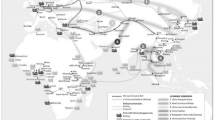Abstract
Coase argued that externality rights should sometimes be flexible, but warned that ambiguity can also hinder market transactions. Flexible liability is not uncommon and can be shown to provide useful information under nonconvexity. At a global optimum, each side must be able to compensate the other. There are also limited incentive gains from flexible liability for private externalities. For public externalities, however, claims will be exaggerated when agents are risk seeking and understated when they are risk averse. Efficient specifications of right are thus unlikely to emerge from self-interested litigation alone.
Similar content being viewed by others
References
BaumolW.J. (1972). “On Taxation and Control of Externalities.” American Economic Review 62, pp. 307–322.
CalebresiG., and D.Melamed. (1972). “Property Rules, Liability Rules, and Inalienability: One View of the Cathedral.” Harvard Law Review 85, pp. 1089–1128.
ChichilniskyGraciela, and GeoffreyHeal. (1993). “Global Environmental Risks.” Journal of Economic Perspectives 7 (Fall), pp. 65–86.
CoaseR.H. (1960). “The Problem of Social Cost.” Journal of Law and Economics 3, pp. 1–44.
CooterRobert J. (1980). “How the Law Circumvents Starrett's Nonconvexity.” Journal of Economic Theory 22, pp. 499–504.
CornesR. (1980). “External Effects: An Alternative Formulation.” European Economic Review 14, pp. 307–321.
CourseyDon L., John L.Hovis, and William D.Schulze. (1987). “The Disparity Between Willingness to Accept and Willingness to Pay Measures of Value.” Quarterly Journal of Economics 102, pp. 79–90.
DavisDouglas D., and Charles A.Holt. (1993). Experimental Economics. Princeton: Princeton University Press.
DiamondPeter A., and Jerry A.Hausmann. (1994). “Contingent Valuation: Is Some Number Better Than No Number?” Journal of Economic Perspectives 8 (Fall), pp. 45–64.
EpsteinRichard A. (1980). “The Static Conception of the Common Law.” Journal of Legal Studies 9, pp. 277–290.
GouldJohn. (1973). “The Economics of Legal Conflicts.” Journal of Legal Studies 2, pp. 279–310.
GreenJerry, and J.-J.Laffont. (1977). “Characterization of Satisfactory Mechanisms for the Revelation of Preferences for Public Goods.” Econometrica 45, pp. 427–438.
GrovesTheodore, and JohnLedyard. (1977). “Optimal Allocation of Public Goods: A Solution to the ‘Free Rider’ Problem.” Econometrica 45, pp. 783–809.
HahnRobert W. (1989). “Economic Prescriptions for Environmental Problems: How the Patient Followed the Doctor's Orders.” Journal of Economic Perspectives 3(2), pp. 95–114.
KahnemanDaniel, Jack L.Knetsch, and Richard H.Thaler. (1990). “Experimental Tests of the Endowment Effect and the Coase Theorem.” Journal of Political Economy 98, pp. 1325–1348.
Maler, Karl-Goran. (1989). Unpublished study on European pollution compensation, cited in “Acid Gains.” Economist, November 25, p. 77.
McCoy, Charles. (1995). “Private Matter: The Push to Expand Property Rights Stirs Both Hopes and Fears.” Wall Street Journal, April 4, p. A1.
MenellPeter S. (1991). “The Limitations of Legal Institutions for Addressing Environmental Risks.” Journal of Economic Perspectives 5(3), pp. 93–101.
MitchellRobert C., and RichardT. Carson. (1989). Using Surveys to Value Public Goods: The Contingent Valuation Method. Washington, DC: Resources for the Future.
PosnerRichard A. (1972). Economic Analysis of the Law. Boston: Little Brown.
PosnerRichard A. (1983). The Economics of Justice. Cambridge, MA: Harvard University Press.
PriestGeorge. (1987). “Measuring Legal Change.” Journal of Law, Economics and Organization 3(2), pp. 193–225.
RizzoMario J. (1980). “Law Amid Flux: The Economics of Negligence and Strict Liability in Tort.” Journal of Legal Studies 9, pp. 291–318.
RubinPaul. (1977). “Why Is the Common Law Efficient.” Journal of Legal Studies 6, pp. 7–23.
Sen, Amartya K. (1979). “Personal Utilities and Public Judgements: Or What's Wrong with Welfare Economics.” Economic Journal (September), 537–558.
Schelling, Thomas C. (1992). “Some Economics of Global Warning.” American Economic Review (March), pp. 1–14.
SchlesingerS., and S.Kinzer. (1982). Bitter Fruit: The Untold Story of the American Coup in Guatemala. New York: Anchor.
Schneider, Keith. (1992). “Environment Laws Face a Stiff Test from Landowners.” New York Times, January 20, p. A1.
ScitovskyTibor. (1941). “A Note on Welfare Propositions in Economics.” Review of Economic Studies 9, 77–88.
StarrettDavid. (1972). “Fundamental Nonconvexities in the Theory of Externalities.” Journal of Economic Theory 4, 180–199.
StarrettDavid, and RichardZeckhsuser. (1974). “Treating External Diseconomies: Markets or Taxes?” In J.W.Pratt (ed.), Statistical and Mathematical Aspects of Pollution Problems. New York: Marcell Dekker.
Stodder, James. (1991). “Hold an Auction to Decide Who Gets the Nuclear Wastes.” Hartford Courant, July 26, p. D13.
Tietenberg, T.H. (1990). “The Poverty Connection to Environmental Policy.” Challenge (September/October), 26–32.
Tomsho, Robert. (1991). “Pollution Ploy: Big Corporations Hit by Superfund Clases Find Way to Share the Bill.” Wall Street Journal, April 2, p. A1.
YeatsWilliam Butler. (1920). “The Second Coming.” Selected Poems. Edited by M.L.Rosenthal. New York: Macmillan.
Author information
Authors and Affiliations
Rights and permissions
About this article
Cite this article
Stodder, J. The evolution of externality rights: Flexibility versus ambiguity. Eur J Law Econ 3, 61–81 (1996). https://doi.org/10.1007/BF00149083
Issue Date:
DOI: https://doi.org/10.1007/BF00149083




